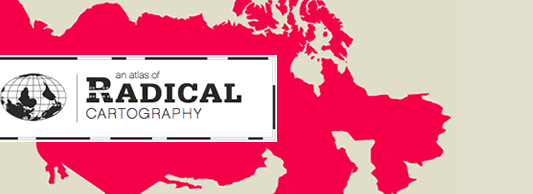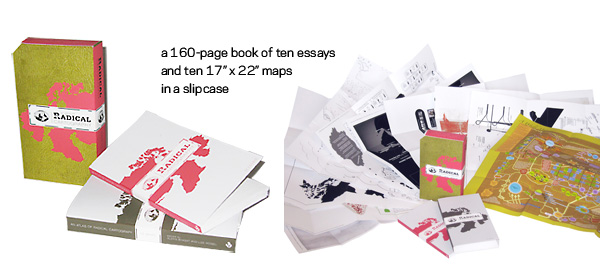


CONTENTS [click each to view]
INTRODUCTION
Alexis Bhagat & Lize Mogel
MAPS
Unnayan | Chetla Lock Gate, Marginal Land Settlement in Calcutta, 1984
Institute for Applied Autonomy with Site-R | Routes of Least Surveillance
Trevor Paglen & John Emerson | Rendition Flights 2001-2006
An Architektur | Geography of the Fürth Departure Center
Pedro Lasch | Guias de Ruta / Route Guides
Lize Mogel | From South to North
Jane Tsong | the los angeles water cycle: the way it is, not the way it should be and one day will be
the Center for Urban Pedagogy (CUP) | New York City Garbage Machine
Brooke Singer | The US Oil Fix
Ashley Hunt | A World Map: in which we see...
ESSAYS
Jai Sen | Other Worlds, Other Maps: Mapping the Unintended City
Institute for Applied Autonomy | Tactical Cartographies
Visible Collective & Trevor Paglen | Mapping Ghosts
Maribel Casas-Cortes & Sebastian Cobarrubias | Drawing Escape Tunnels Through Borders
Alejandro de Acosta | Latino/a America: A Geophilosophy for Wanders
Sarah Lewison | Our Land is Changing-- Soon Yours Will Be Too
Jenny Price, Jane Tsong, Ellen Sollod, Lize Mogel, DJ Waldie, Paul S. Kibel | Drawing (on) Water in Los Angeles
Heather Rogers | The Power of Garbage
Kolya Abramsky | Struggles Over Transition: Emancipating Energy?
Avery F. Gordon | A World Map
CREDITS

| INTRODUCTION | Alexis Bhagat & Lize Mogel This Atlas is an atlas and not the atlas. Rather, it is one of many possible atlases, given the abundance of artists, architects, and others using maps and mapping in their work. While all maps have an inherent politics that often lies hidden beneath an “objective” surface, the contributions to An Atlas of Radical Cartography wear their politics on their sleeve. This publication includes ten pairs of politically engaged maps and texts from within the growing movement of cultural producers who have parallel or integrated activist practices. The simplest of radical cartographies, the “upside-down” world map, appears on the cover of this book. More than a neat trick, this picture of the world has a historical basis in medieval world maps that were sometimes oriented with East or South at top. The modern north-oriented map continually reproduces the idea of the global North and the global South. The “inverted” map calls into question our ingrained acceptance of this particular “global order.” The maps and texts in this book also serve this purpose—to unhinge our beliefs about the world, and to provoke new perceptions of the networks, lineages, associations and representations of places, people and power. Such new understandings of the world are the prerequisites of change. We define radical cartography as the practice of mapmaking that subverts conventional notions in order to actively promote social change. The object of critique in An Atlas of Radical Cartography is not cartography per se (as is generally meant by the overlapping term critical cartography), but rather social relations. Our criteria for selecting these ten maps emphasized radical inquiry and activist engagement. With that in mind, we intend for An Atlas of Radical Cartography to act as a primer on issues which the maps and essays address: identity, land-use, imprisonment, energy, migration. We begin with a text by Jai Sen, a founder of Unnayan, a collective of “radical planners” working in 1980s Kolkata on dwelling rights for the working poor. Unnayan’s map is perhaps the most humble of the collection—but the most literally functional and tied to on-the-ground organizing. The map depicts a community that was preserved in part by mapping it. It illustrates one of the theses of this publication: that if the map is an instrument of power, then that power is available to whoever wields it. The map is as available as a tool for liberation as much as for exploitation. Jai Sen's essay makes use of the concepts of "power-over" and "power-to" to explore this thesis with both insight and self-criticism. Sen wonders what Unnayan’s maps would have looked like, and what their effect would have been, if the people themselves participated in making the map. The New York City Garbage Machine, a map by the Center for Urban Pedagogy (CUP) in collaboration with public high school students, is an example of such an exercise. CUP’s map and Heather Rogers’ related essay put names and faces to the stakeholders of a generally invisible urban infrastructure, each subverting official narratives that place the responsibility for an overburdened waste management system onto consumers. Both Rogers and CUP demonstrate how waste collection policies in New York are shaped more by the desire of corporate capital over the needs of citizens. Desire is transgressive—it moves beyond proscribed boundaries. Pedro Lasch's map imagines the Americas without boundaries altogether. He renames the continental mass Latino/a America, representing a truth of demography absent from conventional maps. Lasch’s maps, given to people crossing the Mexico/US border, bear physical traces of their journeys. In his accompanying essay, Alejandro De Acosta invokes the Nietzschean figure of the wanderer to provoke a similar shift in thinking about migration, representing a truth of mobility absent from current debates. Indirectly, Lasch’s map points to globalization, which simultaneously intensifies and diminishes boundaries between nations. Globalization reinscribes borders in order to loosen the movement of capital while restricting the movement of persons. At the same time, neoliberalism demands the privileged mobility of imperial citizens, both people and corporations, while producing a shadow class of displaced non-citizens. The maps of An Architektur, Ashley Hunt, Pedro Lasch and Lize Mogel together present complementary perspectives on this double movement. In their essay on border mappings in the European Union, Maribel Casas-Cortes and Sebastian Cobarrubias suggest that these activist mappings "serve as organizing nodes rather than just navigational tools. They suggest new connections and relations that aid in not only reconceiving the territory but in recreating it." The essay describes maps that make explicit the usually abstract toll of the control of human movement and migration. The map Geography of the Fürth Departure Center by German collective An Architektur translates this into a local scale, delineating the physical and thus psychic conditions of migration. Together, the map and essay point to the dehumanizing limbo that is created for immigrants and asylum-seekers by the reformulation of the EU’s borders. A similar “state of statelessness” is pictured conceptually in A World Map: In which we see…, Ashley Hunt’s thought-diagram of contemporary capitalism and how bodies are caught up within it. All of the other maps in this collection can be seen as topoi on this "Diagram of a Very Large Complicated Machine," as Avery Gordon describes it in her essay. She points out, "as a whole, the map is unreadable.... You can’t take it all in at once. You start eye-level and you’re in predatory lending and debt leverage, but you can’t see criminalization disappearance internment dispossession institutionalization. Move to the right, flight dispersion; to the left, division of labor.” And so on. This world map contains no territory—it is a topography of procedures. Here, the unhinging of geography and cartography is readily apparent. While Hunt refers to globalization's procedures, Lize Mogel's map refers to its places: From South to North superimposes the man-made Panama Canal and the newly navigable Northwest Passage on top of the San Francisco Bay. The associative geography of both the map and Sarah Lewison’s essay jumps from one place to another, drawing connections, as Lewison writes, “by procedures that both define their relationships and modify them irrevocably.... From a distance, the tangible connections between places become obscured. In close-up, these landscapes—subjected to the same expediencies of development, exploitation and design—begin to look very similar." From South to North, with its landforms set adrift, highlights the problem of spatial hierarchy in the age of globalization. If the San Francisco Bay, the Northwest Passage and the Panama Canal co-create each other, which is the hinterland of which? The two "resource maps" in this collection, Brooke Singer's The U.S. Oil Fix and Jane Tsong's the los angeles water cycle: the way it is, not the way it should and one day will be... rely on more conventional notions of center and margin. In Singer's map, the entire world becomes the fuel pump of the United States, while Tsong's map details connections from the scale of the region down to an urban center. In his response to Singer's map, Kolya Abramsky points out that renewable energy sources could be organized along similarly hierarchical lines and are not inherently progressive. He calls for maps which could imagine, or help to construct, an energy infrastructure of equity and mutual aid. Tsong's diagrammatic drawing is exactly the kind of radical looking that precedes reconstructive vision. As Jenny Price writes, "We modern Americans like to say we're disconnected from nature—but really, we just see our connections less...I think the American habit of defining “connectedness” as intentional and spiritual—of saying we're only connected if we see and embrace those connections—has actually helped make these impossibly abundant connections invisible." In a conversation with Ashley Hunt, Natascha Sadr Haghighian describes "images that create invisibilities."1 Invisibility is not merely an absence, but an active process of erasure, an agent of repression. Trevor Paglen and John Emerson's CIA Rendition Flights 2001-2006 and the Institute for Applied Autonomy's Routes of Least Surveillance are examples of maps that resist such erasure. IAA’s map of surveillance cameras in Manhattan enables "a citizen science of surveillance.” This project, both in its original online and paper form, brings attention to the proliferation of CCTV cameras in the wake of 9/11. Paglen’s map samples his real-time research tracking down “torture taxis” or planes chartered by the CIA for transporting detainees. Both maps are snapshots of a dynamic historical moment. Both are also, as Paglen describes, “aware of all that cartography cannot represent.” Temporality is part of this problem, but more fundamental are complex relationships which can only be understood through analysis, context and interpretation. Radical cartographies are, as Trevor Paglen writes, “a departure point or a tool that can aid in analysis but do not speak for themselves.” The contributions to this publication are part of a fluid movement whose tactics range from art-making to direct action to policy-making. This slow, cumulative, and constant work across many scales of action is what creates social change. ___________ 1. Ashley Hunt interviewed by Natascha Sadr Haghighian. “Representations of the Erased.” March 2007. http://www.16beavergroup.org/ashley/ahunt_3.pdf |